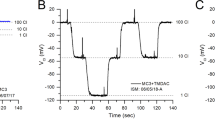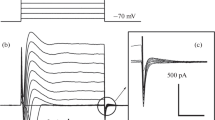Summary
Measurement of intracellular chloride activity in theextensor digitorum longus (EDL) muscle of the rat using liquid ion-exchanger microelectrodes gave an apparent resting value of 10 to 11 mmol liter−1. If chloride ions were distributed passively across the muscle fiber membrane the predicted value would be 4 mmol liter−1. In experiments in which the bathing fluid was changed by (a) reduction of external chloride, or incubation at low external chloride followed by a return to normal concentrations, (b) an increase or reduction in external potassium, (c) alteration in potassium and chloride in the bathing medium so as to maintain a constant [K]×[Cl] product, or in other experiments in which the membrane potential was caused to change by anoxia, or by addition of ouabain to the medium, changes in intracellular chloride activity were invariably consistent with the hypothesis that this ion is passively distributed. Measurements of intracellular chloride activity with recessed-tip solid-state Ag/AgCl electrodes gave a value of 4.6 mmol liter−1. Since the liquid ion-exchanger is known to be poorly selective for chloride, it is concluded that the chloride ion is passively distributed in rat EDL muscle.
Similar content being viewed by others
References
Adrian, R.H. 1960. Potassium chloride movement and the membrane potential of frog muscle.J. Physiol. (London) 151:154–185
Armstrong, W.M., Wojtkowski, W., Bixenman, W.R. 1977. A new solid-state microelectrode for measuring intracellular chloride activities.Biochim. Biophys. Acta 465:165–170
Baumgarten, C.M., Fozzard, H.A. 1978. Intracellular Cl− activity of skeletal and heart muscle.Biophys. J. 21:184a
Bolton, T.B., Vaughan-Jones, R.D. 1977. Continuous direct measurement of intracellular chloride and pH in frog skeletal muscle.J. Physiol. (London) 270:801–833
Boyle, P.J., Conway, E.J. 1941. Potassium accumulation in muscle and associated changes.J. Physiol. (London) 100:1–63
Conway, E.J. 1957. Nature and significance of concentration relations of potassium and sodium ions in skeletal muscle.Physiol. Rev. 37:84–132
Dulhunty, A.F. 1978. The dependence of membrane potential on extracellular chloride concentration in mammalian skeletal muscle fibers.J. Physiol. (London) 276:67–82
Goldmann, D.E. 1943. Potential, impedance and rectification in membranes.J. Gen. Physiol. 27:37–60
Harris, E.J. 1963. Distribution and movement of muscle chloride.J. Physiol. (London) 166:87–109
Hironaka, T., Morimoto, S. 1980. Intracellular chloride concentration and evidence for the existence of a chloride pump in frog skeletal muscle.Jpn. J. Physiol. 30:257–263
Hodgkin, A.L., Horowicz, P. 1959. The influence of potassium and chloride ions on the membrane potential of single muscle fibres.J. Physiol. (London) 148:127–160
Hodgkin, A.L., Katz, B. 1949. The effect of sodium ions on the electrical activity of the giant axon of the squid.J. Physiol. (London) 151:89–102
Hutter, D.F., Warner, A.E. 1967. The pH sensitivity of the chloride conductance of frog skeletal muscle.J. Physiol. (London) 189:403–425
Kernan, R.P., Macdermott, M., Westphal, W. 1974. Measurement of chloride activity within frog sartorius muscle fibres by means of chloride-sensitive microelectrodes.J. Physiol. (London) 241:60P-61P
Leader, J.P. 1982. An improved technique for the construction of a recessed-tip solid-state chloride electrode for intracellular use.Proc. Univ. Otago Med. Sch. 60:34–35
Macchia, D.D., Baumgarten, C.M. 1979. Is chloride passively distributed in skeletal musclein vivo? Pfluegers Arch. 382:193–195
Neild, T.O., Thomas, R.C. 1973. New design for a chloride-sensitive microelectrode.J. Physiol. (London) 231:7P-8P
Saunders, J.H., Brown, H.M. 1977. Liquid and solid-state Cl−-sensitive microelectrodes, characteristics and application to intracellular Cl− activity inBalanus photoreceptor.J. Gen. Physiol. 70:507–530
Spring, K.R., Kimura, G. 1978. Chloride reabsorption by renal proximal tubules ofNecturus.J. Membrane Biol. 38:233–254
Walker, J.L. 1971. Ion-specific ion exchanger microelectrodes.Anal. Chem. 43:89A-92A
Walker, J.L., Brown, H.M. 1977. Intracellular ionic activity measurements in nerve and muscle.Physiol. Rev. 57:729–778
Author information
Authors and Affiliations
Rights and permissions
About this article
Cite this article
McCaig, D., Leader, J.P. Intracellular chloride activity in the extensor digitorum longus (EDL) muscle of the rat. J. Membrain Biol. 81, 9–17 (1984). https://doi.org/10.1007/BF01868805
Received:
Revised:
Issue Date:
DOI: https://doi.org/10.1007/BF01868805




